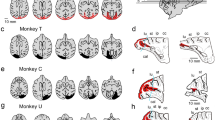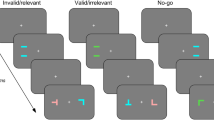Abstract
Damage to the visuoparietal cortex located in the banks of the middle suprasylvian gyrus of the cat has been shown to produce a deficit in the detection and localization of moving visual cues presented in the contralesional visual hemifield. There is evidence from reversible cooling deactivation studies that the integrity of this orienting function is not completely dependent on the VP cortex and that under the right circumstances, other brain regions may come online and completely take over the processing that subserves this behavior. We examined the recovery of orienting behavior after unilateral damage to the VP cortex. We found that consistent with previous data, VP damage produced an impairment in the capacity to detect and orient to moving visual stimuli in the contralesional visual field. Over a span of days, spontaneous recovery fully occurred. The ability to detect and localize static visual stimuli was tested as a fiducial measure of parietal cortex function, and this function did not recover. We conclude that the detection and localization of moving visual stimuli is not a function that requires VP cortex and argue for the existence of a parallel and redundant subcortical-cortical brain network that serves as the substrate for recovery of function.




Similar content being viewed by others
References
Allman BL, Meredith MA (2007) Multisensory processing in “unimodal” neurons: cross-modal subthreshold auditory effects in cat extrastriate visual cortex. J Neurophysiol 98:545–549
Camarda R, Rizzolatti G (1976) Visual receptive fields in the lateral suprasylvian area (Clare-Bishop area) of the cat. Brain Res 101:427–443
Durmer JS, Rosenquist AC (2001) Ibotenic acid lesions in the pedunculopontine region result in recovery of visual orienting in the hemianopic cat. Neuroscience 106:765–781
Fitzmaurice MC, Ciaramitaro VM, Palmer LA, Rosenquist AC (2003) Visual detection deficits following inactivation of the superior colliculus in the cat. Vis Neurosci 20:687–701
Hardy SC, Stein BE (1988) Small lateral suprasylvian cortex lesions produce visual neglect and decreased visual activity in the superior colliculus. J Comp Neurol 273:527–542
Huxlin KR, Pasternak T (2004) Training-induced recovery of visual motion perception after extrastriate cortical damage in the adult cat. Cereb Cortex 14:81–90
Huxlin KR, Williams JM, Price T (2008) A neurochemical signature of visual recovery after extrastriate cortical damage in the adult cat. J Comp Neurol 508:45–61
Lomber SG, Payne BR (1996) Removal of two halves restores the whole: reversal of visual hemineglect during bilateral cortical or collicular inactivation in the cat. Vis Neurosci 13:1143–1156
Lomber SG, Payne BR (2001) Task-specific reversal of visual hemineglect following bilateral reversible deactivation of posterior parietal cortex: a comparison with deactivation of the superior colliculus. Vis Neurosci 18:487–499
Lomber SG, Payne BR (2004) Cerebral areas mediating visual redirection of gaze: cooling deactivation of 15 loci in the cat. J Comp Neurol 474:190–208
Lomber SG, Payne BR, Hilgetag CC, Rushmore J (2002) Restoration of visual orienting into a cortically blind hemifield by reversible deactivation of posterior parietal cortex or the superior colliculus. Exp Brain Res 142:463–474
Pasternak T, Horn KM, Maunsell JH (1989) Deficits in speed discrimination following lesions of the lateral suprasylvian cortex in the cat. Vis Neurosci 3:365–375
Payne BR, Lomber SG, Geeraerts S, van der Gucht E, Vandenbussche E (1996) Reversible visual hemineglect. Proc Natl Acad Sci USA 93:290–294
Payne BR, Lomber SG, Rushmore RJ, Pascual-Leone A (2003) Cancellation of visuoparietal lesion-induced spatial neglect. Exp Brain Res 150:395–398
Rauschecker JP, von Grunau MW, Poulin C (1987) Centrifugal organization of direction preferences in the cat’s lateral suprasylvian visual cortex and its relation to flow field processing. J Neurosci 7:943–958
Reinoso-Suarez F (1961) Topographischer Hirnatlas der Katze. E. Merck AG, Darmstadt
Rosenquist AC (1985) Connections of visual cortical areas in the cat. In: Peters A, Jones E (eds) Cerebral cortex, vol 3. Plenum Press, New York, pp 81–1178
Rosenquist AC, Ciaramitaro VM, Durmer JS, Wallace SF, Todd WE (1996) Ibotenic acid lesions of the superior colliculus produce longer lasting deficits in visual orienting behavior than aspiration lesions in the cat. Prog Brain Res 112:117–130
Rudolph KK, Pasternak T (1996) Lesions in cat lateral suprasylvian cortex affect the perception of complex motion. Cereb Cortex 6:814–822
Rushmore RJ, Payne BR (2004) Neuroplasticity after unilateral visual cortex damage in the newborn cat. Behav Brain Res 153:557–565
Rushmore RJ, Payne BR, Lomber SG (2005) Functional impact of primary visual cortex deactivation on subcortical target structures in the thalamus and midbrain. J Comp Neurol 488:414–426
Rushmore RJ, Valero-Cabre A, Lomber SG, Hilgetag CC, Payne BR (2006) Functional circuitry underlying visual neglect. Brain 129:1803–1821
Sherk H, Kim JN (2002) Responses in extrastriate cortex to optic flow during simulated turns. Vis Neurosci 19:409–419
Spear PD, Baumann TP (1975) Receptive-field characteristics of single neurons in lateral suprasylvian visual area of the cat. J Neurophysiol 38:1403–1420
Sprague JM (1966) Interaction of cortex and superior colliculus in mediation of visually guided behavior in the cat. Science 153:1544–1547
Sprague JM, Meikle TH Jr (1965) The role of the superior colliculus in visually guided behavior. Exp Neurol 11:115–146
Valero-Cabre A, Payne BR, Rushmore J, Lomber SG, Pascual-Leone A (2005) Impact of repetitive transcranial magnetic stimulation of the parietal cortex on metabolic brain activity: a 14C–2DG tracing study in the cat. Exp Brain Res 163:1–12
Van Sluyters RC (2003) Guidelines for the care and use of mammals in neuroscience and behavioral research, report of an institute for laboratory animal research committee. National Research Council of the National Academies. The National Academy Press, Washington
Vanduffel W, Payne BR, Lomber SG, Orban GA (1997) Functional impact of cerebral connections. Proc Natl Acad Sci USA 94:7617–7620
Villeneuve MY, Ptito M, Casanova C (2006) Global motion integration in the postero-medial part of the lateral suprasylvian cortex in the cat. Exp Brain Res 172:485–497
von Grunau M, Frost BJ (1983) Double-opponent-process mechanism underlying RF-structure of directionally specific cells of cat lateral suprasylvian visual area. Exp Brain Res 49:84–92
Wallace SF, Rosenquist AC, Sprague JM (1990) Ibotenic acid lesions of the lateral substantia nigra restore visual orientation behavior in the hemianopic cat. J Comp Neurol 296:222–252
Wong-Riley M (1979) Changes in the visual system of monocularly sutured or enucleated cats demonstrable with cytochrome oxidase histochemistry. Brain Res 171:11–28
Acknowledgments
This study was supported by NS32137 and NS44624. We thank Dr. L.J. Toth, Linda Afifi, and the anonymous reviewers for valuable and thoughtful comments on the manuscript.
Author information
Authors and Affiliations
Corresponding author
Rights and permissions
About this article
Cite this article
Rushmore, R.J., Payne, B. & Valero-Cabre, A. Recovery of function following unilateral damage to visuoparietal cortex. Exp Brain Res 203, 693–700 (2010). https://doi.org/10.1007/s00221-010-2278-3
Received:
Accepted:
Published:
Issue Date:
DOI: https://doi.org/10.1007/s00221-010-2278-3




